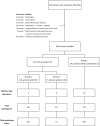Bacterial colonization at caesarean section defects in women of secondary infertility: an observational study
- PMID: 35180844
- PMCID: PMC8857828
- DOI: 10.1186/s12884-022-04471-y
Bacterial colonization at caesarean section defects in women of secondary infertility: an observational study
Abstract
Background: Delayed childbearing has been noted in a high percentage of women with a previous Caesarean section (CS). Many women with CS scar defects (CSDs) present with clinical symptoms of irregular vaginal bleeding. The present study aimed to investigate bacterial colonies at CSDs in women suffering from secondary infertility.
Methods: This observational study included 363 women with secondary infertility who visited the Assisted Reproduction Unit between 2008 and 2013. Among them, 172 women with a previous CS and 191 women with no previous CS were approached. The women with a previous CS had their CS operations in the past 1 to 14 years, with a mean of 3.5 years. The presence of CSDs was detected by vaginal ultrasonography. Bacteriology cultures of specimens taken from the uterine niches in those with CSDs were collected during Day 7 to Day 10 of the follicular phase. Specimens were obtained from the endocervical canal for bacterial culture in those without CSDs. The main outcome measure was the detection of the growth of bacterial colonies.
Results: CSDs were found in 60.4% (96 of 159) of women with a previous CS. In women with a previous CS, bacterial colonies were identified in 89.6% (86 of 96) and 69.8% (44 of 63) of women with and without CSDs, respectively. In women with no previous CS, 49.7% (88 out of 177) of bacterial cultures of endocervical samples showed bacterial colony growth. Gram-positive cocci (P = 0.0017, odds ratio (OR) = 1.576, 95% confidence intervals (CI) -22.5 to - 5.4) and Gram-negative rods (P = 0.0016, OR = 1.74, CI - 20.8 to - 5.0) were the most commonly isolated bacteria and contributed to approximately 90% of all microorganisms found in those with a previous CS. In women with a previous CS, more Gram-negative rods were isolated (P = 0.01, OR = 1.765, CI - 27.2 to - 3.8), especially Pseudomonas species (P = 0.02, OR = 1.97, CI - 16.7 to - 1.0), in those with visible CSDs than in those without CSDs.
Conclusions: Bacterial colonization at CSDs was found in a high percentage of women with secondary infertility.
Keywords: Bacterial colonization; Caesarean section scar defect (CSD); Secondary infertility; Uterine niche.
© 2022. The Author(s).
Conflict of interest statement
No conflicts of interest need to be mentioned in this study.
Figures


References
-
- Hemminki E, Graubard BI, Hoffman HJ, Mosher WD, Fetterly K. Cesarean section and subsequent fertility: results from the 1982 National Survey of family growth. Fertil Steril. 1985;43(4):520–528. - PubMed
-
- Hall M, Campbell D, Fraser C, Lemon J. Mode of delivery and future fertility. BJOG Int J Obstet Gynaecol. 1989;96(11):1297–1303. - PubMed
-
- Leitch C, Walker J. The rise in caesarean section rate: the same indications but a lower threshold. BJOG Int J Obstet Gynaecol. 1998;105(6):621–626. - PubMed
-
- Jolly J, Walker J, Bhabra K. Subsequent obstetric performance related to primary mode of delivery. BJOG Int J Obstet Gynaecol. 1999;106(3):227–232. - PubMed
-
- Murphy D, Stirrat G, Heron J. The relationship between caesarean section and subfertility in a population-based sample of 14 541 pregnancies. Hum Reprod. 2002;17(7):1914–1917. - PubMed
Publication types
MeSH terms
LinkOut - more resources
Full Text Sources
Medical
Miscellaneous

